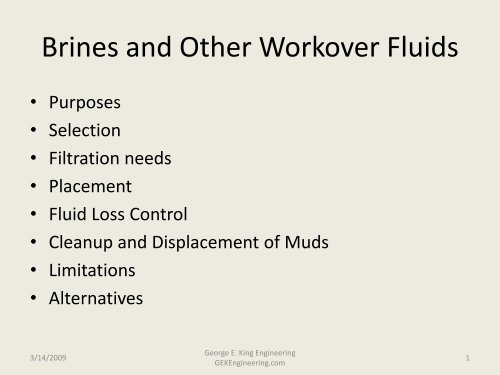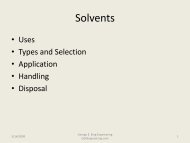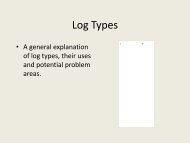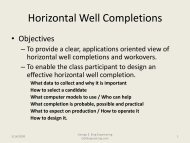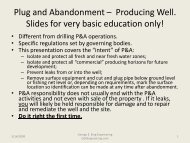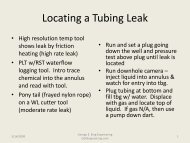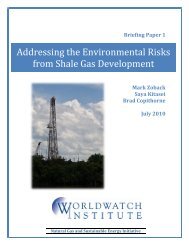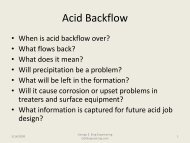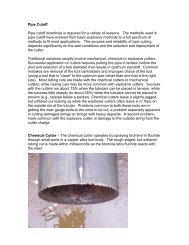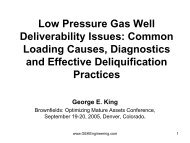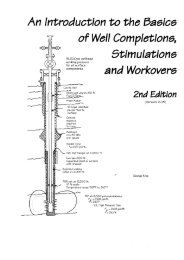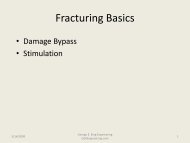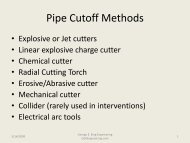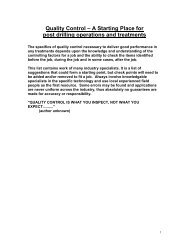Brines and Other Workover Fluids - George E King Engineering
Brines and Other Workover Fluids - George E King Engineering
Brines and Other Workover Fluids - George E King Engineering
You also want an ePaper? Increase the reach of your titles
YUMPU automatically turns print PDFs into web optimized ePapers that Google loves.
<strong>Brines</strong> <strong>and</strong> <strong>Other</strong> <strong>Workover</strong> <strong>Fluids</strong><br />
• Purposes<br />
• Selection<br />
• Filtration needs<br />
• Placement<br />
• Fluid Loss Control<br />
• Cleanup <strong>and</strong> Displacement of Muds<br />
• Limitations<br />
• Alternatives<br />
3/14/2009 1<br />
<strong>George</strong> E. <strong>King</strong> <strong>Engineering</strong><br />
GEK<strong>Engineering</strong>.com
Purposes of <strong>Brines</strong><br />
1. Mud displacement prior to cementing,<br />
2. Debris removal,<br />
3. Controlling formation pressures during completion<br />
<strong>and</strong> intervention operations,<br />
4. Enabling repair operations as a circulating or kill<br />
fluid medium,<br />
5. As packer fluids,<br />
3/14/2009 2<br />
<strong>George</strong> E. <strong>King</strong> <strong>Engineering</strong><br />
GEK<strong>Engineering</strong>.com
Purposes of <strong>Brines</strong> (cont.)<br />
6. In some stimulations as base fluids;<br />
7. Enable cleanup of the zone prior to running screens;<br />
8. Reduce friction while running screens & equipment;<br />
9. Avoid damaging the well after completion,<br />
stimulation, or repair;<br />
10. Allow other well operations to be conducted.<br />
3/14/2009 3<br />
<strong>George</strong> E. <strong>King</strong> <strong>Engineering</strong><br />
GEK<strong>Engineering</strong>.com
Will Circulating a Well Really Clean It Out?<br />
• Not necessarily.<br />
• Clean-out efficiency depends on:<br />
– Ability to remove the solids from returning fluids,<br />
– Fluid hydraulics - the flow rates in every section,<br />
– Ability to disperse, then lift solids out of the well,<br />
– Ability to effectively remove the dope, mud cake,<br />
residues, etc., from the pipe walls.<br />
3/14/2009 4<br />
<strong>George</strong> E. <strong>King</strong> <strong>Engineering</strong><br />
GEK<strong>Engineering</strong>.com
Returns from a cleanout scraper run – dope, wireline grease,<br />
rust, mud, etc., are common components.<br />
3/14/2009 5<br />
<strong>George</strong> E. <strong>King</strong> <strong>Engineering</strong><br />
GEK<strong>Engineering</strong>.com
Selection of the Brine<br />
• Must Satisfy:<br />
1. Well control at every phase of the operation.<br />
2. Must be able to filter the brine to 5 to 10 microns with<br />
beta of 1000.<br />
3. Compatibility with the formation, well equipment <strong>and</strong> all<br />
operations <strong>and</strong> fluids.<br />
4. Corrosion <strong>and</strong> scale dropout must be controllable.<br />
5. Cleanup requirements from the formation<br />
6. Cleanup <strong>and</strong> disposal requirements at the surface<br />
7. Cost <strong>and</strong> availability to fit the well.<br />
3/14/2009 6<br />
<strong>George</strong> E. <strong>King</strong> <strong>Engineering</strong><br />
GEK<strong>Engineering</strong>.com
Brine Types <strong>and</strong> Respective Density Ranges<br />
Brine Type Brine Formula Density Range (ppg)<br />
Chloride Salt NaCl 8.4 - 10.0<br />
Chloride Salt KCl 8.4 - 9.7<br />
Chloride Salt NH4Cl 8.4 - 8.9<br />
Bromide Salt NaBr 8.4 - 12.7<br />
Mix NaCl/NaBr 8.4 - 12.5<br />
Formate Salt NaHCO2 8.4 - 11.1<br />
Formate Salt KHCO2 8.4 - 13.3<br />
Formate Salt CsHCO2 13.0 - 20.0<br />
Formate Salt KHCO2/CsHCO2 13.0 - 20.0<br />
Formate Salt NaHCO2/KHCO2 8.4 - 13.1<br />
Chloride Salt CaCl2 8.4 - 11.3<br />
Bromide Salt CaBr2 8.4 - 15.3<br />
Mix CaCl2/CaBr2 8.4 - 15.1<br />
Bromide Salt ZnBr2 12.0 - 21.0<br />
Mix<br />
Mix<br />
ZnBr2/CaBr2 <strong>George</strong> E. <strong>King</strong> <strong>Engineering</strong><br />
ZnBr2/CaBr2/CaCl2 GEK<strong>Engineering</strong>.com<br />
12.0 - 19.2<br />
12.0 - 19.1<br />
World Oil, Modern S<strong>and</strong><br />
Face Completion, 2003<br />
3/14/2009 7
Lower Density <strong>Fluids</strong><br />
Nitrogen gas 0.1 to 2.6 lb/gal<br />
water foam 3.5 to 8.3 lb/gal<br />
kerosene <strong>and</strong> diesel 6.7 to 7.1 lb/gal<br />
20 o crude 7.8 lb/gal<br />
30 o crude 7.3 lb/gal<br />
Most low density fluids are not be usable because of<br />
migration, flash point, or stability issues.<br />
3/14/2009 8<br />
<strong>George</strong> E. <strong>King</strong> <strong>Engineering</strong><br />
GEK<strong>Engineering</strong>.com
Displacement <strong>and</strong> Pill Design<br />
• The displacement must be designed to obtain<br />
effective mud removal (dispersement <strong>and</strong> lift)<br />
& water wetting of casing.<br />
• Keys:<br />
– disperse <strong>and</strong> thin the drilling fluid<br />
– compatibility with the following fluids (brine, acid, cement,<br />
etc.<br />
– lift out debris <strong>and</strong> junk<br />
– water wet pipe<br />
– remove pipe dope effectively<br />
– displace the mud<br />
Source: Wellcert<br />
<strong>George</strong> E. <strong>King</strong> <strong>Engineering</strong><br />
3/14/2009 9<br />
GEK<strong>Engineering</strong>.com
<strong>Brines</strong> for Displacement<br />
1. A thinning base fluid flush.<br />
2. An effective brine transition system must further thin <strong>and</strong> strip the mud<br />
<strong>and</strong> create wellbore displacement.<br />
3. A carrier spacer must sweep out the solids <strong>and</strong> clean any coating from the<br />
pipe or rock that could cause damage problems.<br />
4. A separation spacer must do the final cleaning <strong>and</strong> separate the residual<br />
mud from the brine.<br />
5. The brine must sweep the spacer out. At this point the well should be<br />
clean.<br />
3/14/2009 10<br />
<strong>George</strong> E. <strong>King</strong> <strong>Engineering</strong><br />
GEK<strong>Engineering</strong>.com
Cleaning <strong>and</strong> Transition Spacers<br />
Spacer Type Function Minimum<br />
Annulus<br />
Coverage<br />
Base Fluid<br />
Thin & mud<br />
condition – start<br />
dispersement<br />
Transition Mud to spacer,<br />
cuttings removal<br />
WBM OBM<br />
250 to 500 ft Water, <strong>and</strong><br />
some brines<br />
Base oil<br />
(composition<br />
varies)<br />
500 to 1000’ Viscous pill Viscous Pill<br />
Wash Clean pipe 500 to 1500’ Water+ WBM<br />
surfactant<br />
Separation Separate wash<br />
from completion<br />
brine<br />
Completion<br />
Fluid<br />
Oil + OBM<br />
surfactant<br />
500 to 1000’ Viscous pill Surfactant gel?<br />
Some water<br />
gels if compat.<br />
Completion fluid Fill Completion<br />
Fluid<br />
Completion<br />
Fluid<br />
3/14/2009 11<br />
<strong>George</strong> E. <strong>King</strong> <strong>Engineering</strong><br />
GEK<strong>Engineering</strong>.com
Pump Rate,<br />
bpm<br />
Brine Flush Contact Times<br />
9-5/8” casing in 12-1/4” hole, annular area = 0.3 ft 2<br />
Annular<br />
Velocity,<br />
ft/min<br />
Barrels<br />
Pumped<br />
Column<br />
Length, ft<br />
Contact<br />
Time,<br />
minutes on<br />
one foot.<br />
8 150 200 3743 25<br />
10 187 400 7486 40<br />
12 225 400 7486 33<br />
3/14/2009 12<br />
<strong>George</strong> E. <strong>King</strong> <strong>Engineering</strong><br />
GEK<strong>Engineering</strong>.com
Flow profile in a well with decentralized pipe. Note That most<br />
of the flow comes along the top of the pipe. This affects<br />
cleanup <strong>and</strong> residence time of the fluid on the wellbore. The<br />
lower section of the wellbore may remain buried in cuttings<br />
<strong>and</strong> never have contact with any of the circulated fluids.<br />
Major flow area<br />
3/14/2009 13<br />
<strong>George</strong> E. <strong>King</strong> <strong>Engineering</strong><br />
GEK<strong>Engineering</strong>.com
Displacement of the annulus to displace fluids <strong>and</strong> mud cake depends partly on velocity.<br />
The annulus changes as casing replaces the drill string. As the annular space decreases –<br />
velocity for any rate increases in the smaller area <strong>and</strong> the back pressure on the bottom hole may<br />
also increase.<br />
Circulating down the casing <strong>and</strong> up the small annulus<br />
can produce very high friction pressure <strong>and</strong> raised<br />
BHP.<br />
3/14/2009 14<br />
<strong>George</strong> E. <strong>King</strong> <strong>Engineering</strong><br />
GEK<strong>Engineering</strong>.com
Displacement Considerations<br />
• Well control is key consideration in selection of<br />
the pill sequence.<br />
• In many cases, it is only possible to get thin, light<br />
fluids into turbulence<br />
• Pumping fluids to displace oil based fluids<br />
without suitable surfactant/solvent packages to<br />
disperse the mud can result in sludges that are<br />
insoluble except in aggressive solvents<br />
• For deepwater wells, low temperatures can<br />
impact surfactant effectiveness<br />
3/14/2009 15<br />
<strong>George</strong> E. <strong>King</strong> <strong>Engineering</strong><br />
GEK<strong>Engineering</strong>.com
Carrying Capacity<br />
• Pills in turbulence lose carrying capacity if<br />
the annular velocity drops below that<br />
required for turbulence (e.g. entering<br />
larger diameter pipe such as a riser)<br />
• In high mud weight, the risk of inducing<br />
barite sag needs to be considered if mud<br />
is thinned (displacement pills thin the mud<br />
to the point it can no longer support barite)<br />
3/14/2009 16<br />
<strong>George</strong> E. <strong>King</strong> <strong>Engineering</strong><br />
GEK<strong>Engineering</strong>.com
LEARNING<br />
• As depth <strong>and</strong> hole angle increase, the minimum pill<br />
volume (based on largest annular hole length)<br />
should increase to allow for contamination, e.g.:<br />
– If MD < twice TVD, annular fill length > 80 m (260 ft),<br />
– If MD > twice TVD, annular fill length > 125 m (410 ft),<br />
• Contact time (the time that critical points in the well<br />
are exposed to the pill) depends on reaction of<br />
surfactant/solvent to mud. For surfactant pills, plan<br />
for contact times of greater than 4 minutes for best<br />
results.<br />
3/14/2009 17<br />
<strong>George</strong> E. <strong>King</strong> <strong>Engineering</strong><br />
GEK<strong>Engineering</strong>.com
BEST PRACTICES AND<br />
DESIGN CRITERIA<br />
• Good mud thinning fluid is continuous phase of the mud:<br />
– for water based mud pumping 50 bbl (8m 3 ) of water<br />
as the first displacement pill will effectively thin mud,<br />
– 50 bbl (8m 3 ) of the mud base fluid can be pumped in<br />
the case of oil based muds. (check oil compatibility)<br />
• Before any displacement, the compatibly of the spacers<br />
with the mud <strong>and</strong> the ability to water wet steel surfaces<br />
should be checked at ambient <strong>and</strong> bottom hole temp to<br />
confirm compatibility.<br />
• In deep water, tests at lower temperature will be needed<br />
3/14/2009 18<br />
<strong>George</strong> E. <strong>King</strong> <strong>Engineering</strong><br />
GEK<strong>Engineering</strong>.com
BEST PRACTICES AND DESIGN<br />
CRITERIA<br />
• All tests should be done on field mud samples to<br />
ensure mud is effectively sheared <strong>and</strong> has<br />
representative particles/cuttings<br />
• Water wetting surfactants are generally effective<br />
>3% vol/vol concentration, little additional benefit<br />
is obtained above 10%.<br />
• Solvents <strong>and</strong> mechanical or hydraulic agitation<br />
are required to remove sludges <strong>and</strong> pipe dope<br />
3/14/2009 19<br />
<strong>George</strong> E. <strong>King</strong> <strong>Engineering</strong><br />
GEK<strong>Engineering</strong>.com
Displacement<br />
• Displacement of mud from an annulus is<br />
complex. The main driving forces:<br />
– time of contact<br />
– flow rate <strong>and</strong> frictional forces<br />
– density<br />
– mechanical agitation<br />
– pipe centralization<br />
3/14/2009 20<br />
<strong>George</strong> E. <strong>King</strong> <strong>Engineering</strong><br />
GEK<strong>Engineering</strong>.com
RISKS AND ISSUES<br />
• Fluid Interface area increases w/ hole angle<br />
• In deviated wells the eccentricity of the<br />
displacement string may reduce displacement.<br />
Pipe rotation <strong>and</strong>/or reciprocation is needed.<br />
• At low temperature (
RISKS AND ISSUES<br />
• High circulation rates may be better (even in laminar<br />
flow), they reduce the boundary layer thickness on the<br />
casing wall. (Watch wash-out potential of soft s<strong>and</strong>s)<br />
• Turbulence is best, flow rate must be calculated allowing<br />
for pipe eccentricity. A complete wellbore hydraulics<br />
check is necessary.<br />
• High rates (300 ft/min?) may reduce the fluff (80% of the<br />
outer layer of the filter cake that does not contribute to<br />
fluid loss control); sharply reducing the amount of solids<br />
in the well without reducing fluid loss control.<br />
3/14/2009 22<br />
<strong>George</strong> E. <strong>King</strong> <strong>Engineering</strong><br />
GEK<strong>Engineering</strong>.com
BEST PRACTICES AND DESIGN<br />
CRITERIA<br />
• High flow rates will always be better even if turbulence<br />
cannot be achieved<br />
• Pipe movement will improve displacement efficiency.<br />
• Multi-function circulating subs should be used, currently<br />
the best tools open by setting weight down, incorporating<br />
a clutch mechanism to allow rotation.<br />
• Do not stop displacement once pills enter the annulus<br />
• Circulate to warm mud <strong>and</strong> fine up shakers (increase<br />
screen mesh number) to reduce particles in the fluid<br />
when possible, condition mud (reduce rheology).<br />
• Use reverse circulation if possible when displacing with<br />
lighter fluids.<br />
3/14/2009 23<br />
<strong>George</strong> E. <strong>King</strong> <strong>Engineering</strong><br />
GEK<strong>Engineering</strong>.com
Muds, Cakes, Breakers <strong>and</strong> Particles<br />
• Drilling mud is the best known particulate based fluid<br />
loss control system.<br />
• Particles are sized to bridge on the face of the<br />
formation. Carbonate <strong>and</strong> salt are most common.<br />
• Breakers are acid, oxidizers <strong>and</strong> enzymes.<br />
• Filter cakes very effective in preventing losses as long<br />
as over-balance pressure is maintained.<br />
• Cakes are very sensitive to swabbing, but are never<br />
completely removed..<br />
• Tool systems sensitive to plugging by particulates.<br />
3/14/2009 24<br />
<strong>George</strong> E. <strong>King</strong> <strong>Engineering</strong><br />
GEK<strong>Engineering</strong>.com
Particles – Damage?<br />
• “Dirty” particles, unsized particles, debris <strong>and</strong> pipe<br />
dope are severe formation damage problems.<br />
• Protecting the perforations with the right particles<br />
during a workover improves chances of well<br />
improvement afterwards.<br />
• The type of carrier fluid <strong>and</strong> the gels are v. important<br />
Clear (no particles) brines are not always best solution<br />
3/14/2009 25<br />
<strong>George</strong> E. <strong>King</strong> <strong>Engineering</strong><br />
GEK<strong>Engineering</strong>.com
Particulate Pill Displacement<br />
• A spacer or displacement pill for displacing a<br />
polymer system carring sized particulates<br />
should be 0.2 to 0.25 ppg heavier <strong>and</strong> about<br />
three times the low shear rate viscosity (at<br />
0.06 sec -1) of the fluid being displaced.<br />
3/14/2009 26<br />
<strong>George</strong> E. <strong>King</strong> <strong>Engineering</strong><br />
GEK<strong>Engineering</strong>.com
Data from a set of Alaska wells where the perforations were<br />
not protected during a workover. No protection shows<br />
significant long term damage.<br />
% Change in PI<br />
40<br />
20<br />
0<br />
-20<br />
-40<br />
-60<br />
-80<br />
-100<br />
1<br />
3<br />
PI Change, Perfs Not Protected<br />
5<br />
PI of Wells<br />
0.3 0.5 1.1 2.1 3.1 6 18.9<br />
7<br />
9<br />
11<br />
13<br />
15<br />
Short Term PI Change<br />
Long Term PI Change<br />
SPE 26042<br />
<strong>George</strong> E. <strong>King</strong> <strong>Engineering</strong><br />
3/14/2009 27<br />
GEK<strong>Engineering</strong>.com
When perfs were protected, that was little risk of long term damage.<br />
% Change in PI<br />
50<br />
40<br />
30<br />
20<br />
10<br />
0<br />
-10<br />
-20<br />
-30<br />
-40<br />
PI Change After <strong>Workover</strong> - Perfs Protected<br />
PI of wells<br />
0.3 1.2 3.1 4.6 8.4<br />
1 2 3 4 5 6 7 8 9 10 11<br />
Short Term PI Change<br />
Long Term PI Change<br />
SPE 26042<br />
<strong>George</strong> E. <strong>King</strong> <strong>Engineering</strong><br />
3/14/2009 28<br />
GEK<strong>Engineering</strong>.com
Sized particulates, particularly those that can be removed, are much less damaging than most<br />
polymers.<br />
% Change in PI<br />
10<br />
5<br />
0<br />
-5<br />
-10<br />
-15<br />
-20<br />
-25<br />
Kill Pills: Summary of Overall Effectiveness in<br />
Non Fractured Wells<br />
Sized Borate Salts<br />
(4)<br />
Cellulose<br />
Fibers (3)<br />
Sized Sodium<br />
Chloride (12)<br />
1 2 3 4 5 6 7<br />
SPE 26042<br />
No Near Perf Milling<br />
(6)<br />
HEC Pills No Pills<br />
Near Perf Milling or<br />
Scraping (3)<br />
No Near Perf<br />
Milling (8)<br />
Near Perf Milling<br />
or Scraping (10)<br />
3/14/2009 29<br />
<strong>George</strong> E. <strong>King</strong> <strong>Engineering</strong><br />
GEK<strong>Engineering</strong>.com
• Gels<br />
Formation Damage by Gels<br />
– Linear gels not recommended for high<br />
overbalance or high permeability formations – too<br />
much depth of damage.<br />
– HEC is not always clean breaking.<br />
– Breaker selection is critical to removing the<br />
damage from a linear gel.<br />
3/14/2009 30<br />
<strong>George</strong> E. <strong>King</strong> <strong>Engineering</strong><br />
GEK<strong>Engineering</strong>.com
Pill Vol. Required, bbl per ft of zone<br />
3<br />
2.5<br />
2<br />
1.5<br />
1<br />
0.5<br />
0<br />
Linear HEC Pill needed per ft of zone, 80 lb/1000<br />
gal or 3.36 ppb<br />
1000 750 500 250<br />
Overbalance Pressure, psi<br />
1 Darcy<br />
500 md<br />
250 md<br />
100 md<br />
World Oil, Modern<br />
S<strong>and</strong>face Completion<br />
Practices, 2003<br />
<strong>George</strong> E. <strong>King</strong> <strong>Engineering</strong><br />
3/14/2009 31<br />
GEK<strong>Engineering</strong>.com
Loss Rate, bbl / hr / ft of zone height<br />
6<br />
5<br />
4<br />
3<br />
2<br />
1<br />
0<br />
Fluid Loss Rate vs. Pressure Differential for<br />
Various Permeabilities<br />
0 100 200 300 400 500<br />
Overbalance Pressure, psi<br />
1 cp fluid,<br />
s = +5<br />
500 md<br />
250 md<br />
100 md<br />
50md<br />
Modified from World<br />
Oil, Modern S<strong>and</strong>face<br />
Completion Practices,<br />
2003<br />
<strong>George</strong> E. <strong>King</strong> <strong>Engineering</strong><br />
3/14/2009 32<br />
GEK<strong>Engineering</strong>.com
Breaker<br />
• Breaker must stay with the part of the gel that<br />
causes the damage<br />
– penetrate to the distance that gel penetrates, or<br />
– stop at the wall – with the gel wall cake.<br />
• Breakers:<br />
– Acid, internal breaker, or enzyme<br />
– Many breakers adsorb or spend in the formation,<br />
before they work.<br />
3/14/2009 33<br />
<strong>George</strong> E. <strong>King</strong> <strong>Engineering</strong><br />
GEK<strong>Engineering</strong>.com
Brine Stability<br />
• The stability of the brines at high salt loadings can be<br />
very “touchy” with temperature drops causing salt<br />
precipitation.<br />
• Increases in temperature decreases brine density<br />
<strong>and</strong> may leave the brine under-saturated to salt.<br />
• Additions of gas, alcohol, some surfactants, shear<br />
<strong>and</strong> reduction in temperature can lead to salt<br />
precipitation.<br />
• Salt may affect the way polymers hydrate or disperse.<br />
3/14/2009 34<br />
<strong>George</strong> E. <strong>King</strong> <strong>Engineering</strong><br />
GEK<strong>Engineering</strong>.com
Brine Density (lb/gal)<br />
17<br />
16.8<br />
16.6<br />
16.4<br />
16.2<br />
16<br />
15.8<br />
15.6<br />
15.4<br />
15.2<br />
15<br />
NaCl Brine Density Variance with<br />
Temperature<br />
100 o C<br />
20 o C The reduction of brine density<br />
as it comes to equilibrium in<br />
the well may explain why a well<br />
can go from a no-flow<br />
condition to flow within a few<br />
hours after being killed.<br />
60 110 160 210 260 310 360<br />
Temperature (F)<br />
<strong>George</strong> E. <strong>King</strong> <strong>Engineering</strong><br />
3/14/2009 35<br />
GEK<strong>Engineering</strong>.com<br />
SPE 12490
Water Depth, ft<br />
0<br />
2000<br />
4000<br />
6000<br />
8000<br />
10000<br />
12000<br />
14000<br />
Temperature Changes<br />
GOM Seafloor Temperature<br />
Sea Floor Temperature, F<br />
35 40 45 50 55 60<br />
<strong>George</strong> E. <strong>King</strong> <strong>Engineering</strong><br />
3/14/2009 36<br />
GEK<strong>Engineering</strong>.comComposite<br />
data from DTC
0<br />
2000<br />
4000<br />
6000<br />
8000<br />
10000<br />
12000<br />
14000<br />
16000<br />
18000<br />
Temperatures in the Well?<br />
Circulating or High Rate Injection?<br />
30 40 50 60 70 80 90 100 110 120 130<br />
BHCT= 98*F<br />
Circulation pump rate = 8-BPM<br />
Tubing<br />
Tbg Fluid<br />
Casing 1<br />
Undisturbed<br />
BHST= 122*F<br />
0<br />
2000<br />
4000<br />
6000<br />
8000<br />
10000<br />
12000<br />
14000<br />
16000<br />
18000<br />
30 40 50 60 70 80 90 100 110 120 130<br />
BHTT= 86*F<br />
Frac job pump rate = 35-BPM<br />
Undisturbed<br />
Tbg Fluid<br />
Tubing<br />
Casing 1<br />
BHST= 125*F<br />
<strong>George</strong> E. <strong>King</strong> <strong>Engineering</strong><br />
3/14/2009 37<br />
GEK<strong>Engineering</strong>.com
Salt-Out or “Freezing” Temperature of a Brine<br />
Crystallization Temp<br />
Salt Content<br />
Adding salt lowers<br />
freezing point of water<br />
until the point at which<br />
additional salt precipitates<br />
Eutectic Point<br />
3/14/2009 38<br />
<strong>George</strong> E. <strong>King</strong> <strong>Engineering</strong><br />
GEK<strong>Engineering</strong>.com
Composition Determines TCT (true<br />
crystallization temperature)<br />
Density CaCl 2 CaBr 2 TCT<br />
(ppg)* (wt %) (wt %) ( O F / O C)<br />
12.5 34.40 10.80 60/ 15.5<br />
12.5 32.20 13.13 44/ 6.7<br />
12.5 22.84 20.55 15/ - 2.8<br />
12.5 00.00 41.55 - 33/ - 36<br />
*1.50 SG<br />
3/14/2009 39<br />
<strong>George</strong> E. <strong>King</strong> <strong>Engineering</strong><br />
GEK<strong>Engineering</strong>.com
Density Change with Temp Change<br />
D DH = D S (1 + 0.000252 (T S - T DH))<br />
What is downhole density (D DH) of a 16.4 lb/gal<br />
surface density (D s) brine (60 o F) when downhole<br />
temperature increases to 230 o F?<br />
D DH = (16.4) (1 + 0.000252 (60-230)<br />
D DH = 15.7 lb/gal<br />
<strong>George</strong> E. <strong>King</strong> <strong>Engineering</strong><br />
3/14/2009 Formula from OSCA 40<br />
GEK<strong>Engineering</strong>.com
There is a slight increase in density with applied pressure, usually about 0.1 ppg.<br />
Brine Density (g/cc)<br />
2.4<br />
2.2<br />
2<br />
1.8<br />
1.6<br />
1.4<br />
1.2<br />
1<br />
Brine Density Change with Pressure<br />
0 1000 2000 3000<br />
Pressure, psi<br />
ZnBr2/CaBr2 (19%<br />
/wt)<br />
ZnBr2/CaBr2/CaCl2<br />
(37% /wt)<br />
CaBr2 (45% /wt)<br />
NaBr (54% /wt)<br />
CaCl2 (65% /wt)<br />
NaCl (70% /wt)<br />
Typical change was 0.0015 g/cc<br />
<strong>George</strong> E. <strong>King</strong> <strong>Engineering</strong><br />
3/14/2009<br />
SPE 12490<br />
41<br />
GEK<strong>Engineering</strong>.com
Temperature <strong>and</strong> Pressure Effects on Completion <strong>Fluids</strong><br />
Temp Expansion of <strong>Fluids</strong> Pressure Effect on <strong>Fluids</strong><br />
Expansion Coef. Compression Coef.<br />
Fluid System Density, ppg vol/vol/ o Fx10 4<br />
lb/gal/100 o F vol/vol/ o Fx10 6<br />
lb/gal/1000 psi<br />
Diesel 7 3.8<br />
NaCl 9.49 2.54 0.24 1.98 0.019<br />
CaCl2 11.45 2.39 0.27 1.5 0.017<br />
NaBr 12.48 2.67 0.33 1.67 0.021<br />
CaBr2 14.3 2.33 0.33 1.53 0.022<br />
ZnBr2/CaBr2/CaCl2 16.01 2.27 0.36 1.39 0.022<br />
ZnBr2/CaBr2 19.27 2.54 0.48 1.64 0.031<br />
At 12,000 psi from 76F to 345F At 198F from 2,000 to 12,000 psi<br />
World Oil, Modern<br />
S<strong>and</strong> Face Completion,<br />
2003<br />
<strong>George</strong> E. <strong>King</strong> <strong>Engineering</strong><br />
3/14/2009 42<br />
GEK<strong>Engineering</strong>.com
Brine Selection – Circulating<br />
Density<br />
• Match density needs on both static (ESD) needs,<br />
<strong>and</strong> circulating density (ECD) needs. Consider<br />
friction effects on BH press while circulating.<br />
• Remember – brine must exert pressures in a<br />
window between controlling pore pressure or shale<br />
heaving <strong>and</strong> fracturing the formation.<br />
• Brine density changes with temperature (can drop<br />
by >1 lb/gal) <strong>and</strong> a small increase with pressure<br />
(0.1 lb/gal).<br />
• Carried solids add density to the brine – easily by<br />
0.5 to 2+ lb/gal.<br />
3/14/2009 43<br />
<strong>George</strong> E. <strong>King</strong> <strong>Engineering</strong><br />
GEK<strong>Engineering</strong>.com
<strong>Brines</strong> have small density changes due to temperature, pressure, <strong>and</strong> contamination; <strong>and</strong> larger<br />
density changes due to suspended solids.<br />
Note: Fluid<br />
Density is<br />
Greater at the<br />
Mud line than<br />
at the Surface<br />
Courtesy of MI-LLC<br />
CaCl 2 Brine in a 14,000 ft<br />
Wellbore in 8,000 ft Water<br />
True Vertical Depth - (ft)<br />
0<br />
2000<br />
4000<br />
6000<br />
8000<br />
10000<br />
12000<br />
14000<br />
16000<br />
ESD - (lb/gal)<br />
11.35 11.40 11.45 11.50<br />
ESD<br />
Hydrostatic Pressure at TVD<br />
True Vertical Depth - (ft)<br />
0<br />
2000<br />
4000<br />
6000<br />
8000<br />
10000<br />
12000<br />
14000<br />
16000<br />
BH Pressure - (psi)<br />
0 5000 10000<br />
<strong>George</strong> E. <strong>King</strong> <strong>Engineering</strong><br />
3/14/2009 44<br />
GEK<strong>Engineering</strong>.com<br />
Pressure
Adding solids to any fluid, either at the surface or<br />
downhole increases it density. 0.5 to 2+ lb of solids<br />
are common in cleanout with circulated fluids.<br />
3/14/2009 45<br />
<strong>George</strong> E. <strong>King</strong> <strong>Engineering</strong><br />
GEK<strong>Engineering</strong>.com
Completion Fluid - Checklist<br />
• Is the formation liquid sensitive to liquid relative permeability effects?<br />
• Compatibility with formation? (clay <strong>and</strong> minerals)<br />
• Compatibility with formation fluid? (emulsion, sludge, foam, froth)<br />
• Tanks <strong>and</strong> surface equipment clean?(pumps, lines, hoses, blenders)<br />
• Are polymers breakable? How is breaker added?<br />
• Polymers, hydrated, sheared <strong>and</strong> filtered? Filter level? Beta rating?<br />
• Minimize the pipe dope?<br />
• Corrosion reactions understood?<br />
• Erosion potential understood?<br />
3/14/2009 46<br />
<strong>George</strong> E. <strong>King</strong> <strong>Engineering</strong><br />
GEK<strong>Engineering</strong>.com
Special Case - Horizontal Wells<br />
• Hole circulated to a large volume of fluid to stop<br />
losses.<br />
• Minimum amount of solids can be used where<br />
internal tool sticking is a possibility<br />
• Suspension of solids beyond 60 o deviation is difficult.<br />
• Penetration to furthest reaches of the well is<br />
required – buckling considerations?<br />
• Very sensitive to swabbing.<br />
3/14/2009 47<br />
<strong>George</strong> E. <strong>King</strong> <strong>Engineering</strong><br />
GEK<strong>Engineering</strong>.com
Filtration <strong>and</strong> Cleaning<br />
• Brine <strong>and</strong> ? (tanks, lines, pumps, etc.)<br />
• Pickle the tubulars?<br />
• NTU or particle count as a measure? How clean is<br />
clean? = Avg pore throat x 0.2?<br />
• Beta rating <strong>and</strong> micron rating important<br />
• Tank arrangement when filtering (from dirty tank to<br />
clean, not in a loop)<br />
• Filter type<br />
– DE or Cartridge (no resin coated cartridges)<br />
3/14/2009 48<br />
<strong>George</strong> E. <strong>King</strong> <strong>Engineering</strong><br />
GEK<strong>Engineering</strong>.com
3/14/2009 49<br />
<strong>George</strong> E. <strong>King</strong> <strong>Engineering</strong><br />
GEK<strong>Engineering</strong>.com
Filtration Ratings<br />
• NTU - a turbidity indicator - can be mislead by natural color of<br />
water. An NTU of 20 to 30 is generally clean.<br />
• Nominal filter rating - estimate of the size of particle removed<br />
- don’t trust it. Filtration efficiency improves with bed build-up<br />
• Absolute filter rating - size of the holes in the filter. Filtration<br />
efficiency improves with bed build-up<br />
• Beta rating - a ratio of particles before filtration to after. A<br />
good measure of filter efficiency.<br />
• Suggestion – use a 5 to 10 micron rating with a beta rating of<br />
1000 for most clear brine applications.<br />
3/14/2009 50<br />
<strong>George</strong> E. <strong>King</strong> <strong>Engineering</strong><br />
GEK<strong>Engineering</strong>.com
Beta Rating<br />
• Beta = number of filter rating <strong>and</strong> larger size<br />
particles in dirty fluid divided by number of<br />
those particles in clean fluid.<br />
• Beta = 1000/1 = 1000 or 99.99% clean<br />
3/14/2009 51<br />
<strong>George</strong> E. <strong>King</strong> <strong>Engineering</strong><br />
GEK<strong>Engineering</strong>.com
Filtration Considerations<br />
• Very clean fluids have high leakoff rates<br />
• <strong>Fluids</strong> with properly blended fluid loss control<br />
materials added after filtration have a better<br />
chance of cleanup than with the initial<br />
particles in the fluid. Particles must be sized<br />
to stop at the face of the formation.<br />
• All gelled fluids should be sheared <strong>and</strong> filtered<br />
– even the liquid polymer fluids.<br />
3/14/2009 52<br />
<strong>George</strong> E. <strong>King</strong> <strong>Engineering</strong><br />
GEK<strong>Engineering</strong>.com
3/14/2009 53<br />
<strong>George</strong> E. <strong>King</strong> <strong>Engineering</strong><br />
GEK<strong>Engineering</strong>.com
Solid Microgels polymer or “fisheyes” lumps or “Fisheyes” after straining <strong>and</strong> a microgels liquid HEC filtered dispersion from through liquid HEC a 200 polymer. mesh screen in a<br />
shear <strong>and</strong> filter operation for gravel pack fluid preparation.<br />
3/14/2009 54<br />
<strong>George</strong> E. <strong>King</strong> <strong>Engineering</strong><br />
GEK<strong>Engineering</strong>.com
Scrapers <strong>and</strong> Brushes – Physically<br />
• Available tools<br />
• Damage potential<br />
Cleaning the Well<br />
3/14/2009 55<br />
<strong>George</strong> E. <strong>King</strong> <strong>Engineering</strong><br />
GEK<strong>Engineering</strong>.com
One very detrimental action was running a scraper prior to packer setting. The<br />
scraping <strong>and</strong> surging drives debris into unprotected perfs.<br />
% Change in PI<br />
20<br />
10<br />
0<br />
-10<br />
-20<br />
-30<br />
-40<br />
-50<br />
-60<br />
Effect of Scraping or Milling Adjacent to Open<br />
Perforations<br />
Perfs not protected by<br />
LCM prior to scraping<br />
1 Perfs protected 2 by<br />
LCM<br />
Short Term PI Change<br />
Long Term PI Change<br />
SPE 26042<br />
3/14/2009 56<br />
<strong>George</strong> E. <strong>King</strong> <strong>Engineering</strong><br />
GEK<strong>Engineering</strong>.com
Casing Scraper – Designed to knock off<br />
perforation burrs, lips in tubing pins,<br />
cement <strong>and</strong> mud sheaths, scale, etc.<br />
It cleans the pipe before setting a<br />
packer or plug.<br />
The debris it turns loose from the pipe<br />
may damage the formation unless the<br />
pay is protected by a LCM or plug.<br />
3/14/2009 57<br />
<strong>George</strong> E. <strong>King</strong> <strong>Engineering</strong><br />
GEK<strong>Engineering</strong>.com
3/14/2009 58<br />
<strong>George</strong> E. <strong>King</strong> <strong>Engineering</strong><br />
GEK<strong>Engineering</strong>.com
Placement Methods<br />
• Circulating – preferred – watch effective circulation density<br />
(friction pressures)<br />
• Spotting – watch density induced drift – 0.05 lb/gal difference<br />
can start density migration.<br />
• Bullheading - next to last resort.<br />
• Lubricating - last resort.<br />
• Consider coiled tubing for most accurate spotting<br />
<strong>and</strong> ability to circulate fluids into place with<br />
minimum contamination.<br />
• Remember that fluid density differences of even 0.05<br />
lb/gal will start density segregation.<br />
3/14/2009 59<br />
<strong>George</strong> E. <strong>King</strong> <strong>Engineering</strong><br />
GEK<strong>Engineering</strong>.com
Fluid Loss Control<br />
• Methods: viscosity, particulates, mechanical<br />
• Best method? – depends on application <strong>and</strong> options<br />
afterward.<br />
– Viscosity based methods often leave polymer debris<br />
– Particulates must be sized with small, medium <strong>and</strong> large<br />
particles to build a tight cake at the surface. Don’t use<br />
them in cased <strong>and</strong> perforated completions???<br />
– Mechanical methods preferred, but not always practical.<br />
3/14/2009 60<br />
<strong>George</strong> E. <strong>King</strong> <strong>Engineering</strong><br />
GEK<strong>Engineering</strong>.com
Fluid Loss Control Systems<br />
fluid (pumped) mechanical<br />
gels (linear <strong>and</strong> x-link)<br />
bridging particulates<br />
micron particles<br />
resin particles<br />
larger mixed particles<br />
downhole valves<br />
plugs<br />
flappers (watch the throat<br />
size)<br />
ball checks<br />
Removal methods? Removal methods?<br />
3/14/2009 61<br />
<strong>George</strong> E. <strong>King</strong> <strong>Engineering</strong><br />
GEK<strong>Engineering</strong>.com
In the Formation / At the<br />
Formation Face (Not in Perf)<br />
• Gels – high vis. limits the<br />
fluid loss by pressure<br />
drop.<br />
– May not work in high perm<br />
(>0.5 darcy).<br />
– Temperature greatly affects<br />
performance.<br />
– Cleanup is a problem.<br />
• Particulates bridge at the<br />
formation face.<br />
Particulates are very effective in controlling fluid loss, but are also very sensitive to<br />
swabbing, dissolving in carrier fluids <strong>George</strong> <strong>and</strong> E. <strong>King</strong> must <strong>Engineering</strong><br />
3/14/2009 be sized for the formation pores 62 <strong>and</strong><br />
GEK<strong>Engineering</strong>.com<br />
natural fractures.
Particulate Systems<br />
• Sized carbonates <strong>and</strong> salts are most common.<br />
Penetration depth = 0.125” (3mm)<br />
• Do not use in most perforated completions unless<br />
the perforations have been packed with gravel.<br />
• Gravel pack tools <strong>and</strong> tools with close clearances<br />
should not be exposed to particulate laden fluids.<br />
• Gel carriers for particulates still require breakers.<br />
3/14/2009 63<br />
<strong>George</strong> E. <strong>King</strong> <strong>Engineering</strong><br />
GEK<strong>Engineering</strong>.com
Considerations for Fluid loss<br />
Control Selection<br />
BHT Formation sensitivity<br />
to treatment fluids<br />
BHP Treatment/completion<br />
fluid types<br />
Overbalance or<br />
underbalance<br />
Vertical <strong>and</strong> horizontal<br />
permeability variations<br />
Formation s<strong>and</strong> size<br />
<strong>and</strong> pore throat size<br />
Frequency <strong>and</strong> amount<br />
of surge/swab loads<br />
Formation s<strong>and</strong><br />
strength<br />
S<strong>and</strong> production <strong>and</strong><br />
presence of cavity<br />
Onshore / Offshore /<br />
Deepwater<br />
Rig cost per day<br />
Rig equip available -<br />
pumps, tanks, lines,<br />
All tubular sizes in the<br />
flow path<br />
Mobilization time<br />
available<br />
Production rate Producer or injector Regulations on use <strong>and</strong><br />
disposal<br />
Produced fluid types Wellbore deviation<br />
through the pay<br />
Natural or hydraulic<br />
fractures present<br />
3/14/2009<br />
<strong>George</strong> E. <strong>King</strong> <strong>Engineering</strong><br />
GEK<strong>Engineering</strong>.com<br />
64<br />
SPE 54323
Areas for Fluid Loss Control<br />
• In formation matrix<br />
• At the formation face<br />
• Inside the perf tunnel<br />
• On the fracture pack<br />
• Inside the casing (on<br />
the perforation)<br />
• On a s<strong>and</strong>-back plug<br />
• In the gravel<br />
• Inside the screen<br />
• Above the screen or in<br />
the BHA<br />
• Inside the tubing<br />
• At the surface<br />
Each location requires different plug<br />
construction methods <strong>and</strong> removal<br />
considerations.<br />
3/14/2009 65<br />
<strong>George</strong> E. <strong>King</strong> <strong>Engineering</strong><br />
GEK<strong>Engineering</strong>.com
Cleanup<br />
• Gel break <strong>and</strong> damage issues<br />
• Fluid imbibition effects<br />
• <strong>Other</strong> fluid unloading issues<br />
3/14/2009 66<br />
<strong>George</strong> E. <strong>King</strong> <strong>Engineering</strong><br />
GEK<strong>Engineering</strong>.com
Cleanup<br />
• How to remove from the reservoir (through the<br />
fractures or the matrix). Is a surface/interfacial<br />
reduction surfactant needed? Is gas needed? Is the<br />
formation initially undersaturated to water (yes, it<br />
can <strong>and</strong> does happen).<br />
• From the wellbore – effective unloading is plagued<br />
by well deviation <strong>and</strong> low flow rates from small<br />
coiled tubing <strong>and</strong> other non rotating strings.<br />
3/14/2009 67<br />
<strong>George</strong> E. <strong>King</strong> <strong>Engineering</strong><br />
GEK<strong>Engineering</strong>.com
Problems - unwanted foams during<br />
backflow<br />
• Foam is an emulsion where gas is the internal phase<br />
(mist is an emulsion with gas as external phase).<br />
Foams are used to unload brines – BUT the forms<br />
may cause a problem at the surface.<br />
• Foaming conditions<br />
– some oils (ppm conc. of C6-C9organic acids <strong>and</strong> alcohols)<br />
– diesel - (particularly bad <strong>and</strong> varies from lot to lot)<br />
– some acid additives (emulsifiers, salts, inhibitors)<br />
– XCD polymers (<strong>and</strong> others)<br />
• Look for <strong>and</strong> destroy the stabilizer to break the foam.<br />
3/14/2009 68<br />
<strong>George</strong> E. <strong>King</strong> <strong>Engineering</strong><br />
GEK<strong>Engineering</strong>.com
Brine Tankage Required<br />
1. Volume of prod. Casing – annulus & below packer?<br />
2. Displacement volume of work string<br />
3. Displacement volume of producing string including packers<br />
4. Volume of manifolds, lines, hoses <strong>and</strong> pumps<br />
5. Volume of transport tankage (usable)<br />
6. Volume of filtering system (all tanks, lines <strong>and</strong> pods)<br />
7. Volume of pill tank<br />
8. Pickle flush volume<br />
9. Spare volume for safe operation<br />
3/14/2009 69<br />
<strong>George</strong> E. <strong>King</strong> <strong>Engineering</strong><br />
GEK<strong>Engineering</strong>.com
Special Topics<br />
• Alternatives to a clear brine<br />
• Gravel pack brines<br />
• Brine h<strong>and</strong>ling <strong>and</strong> preparation<br />
• Solids free gels<br />
• Corrosion<br />
• Hydrates<br />
• Best Practice Learnings<br />
• Toxicity<br />
3/14/2009 70<br />
<strong>George</strong> E. <strong>King</strong> <strong>Engineering</strong><br />
GEK<strong>Engineering</strong>.com
Alternatives to a Clear Brine<br />
• Emulsions, Foams, Muds<br />
– Will it be stable?<br />
– What will stop fluid loss?<br />
– What will clean up or degrade?<br />
– What will damage least?<br />
– Can an oil be ever be used in a gas zone??<br />
3/14/2009 71<br />
<strong>George</strong> E. <strong>King</strong> <strong>Engineering</strong><br />
GEK<strong>Engineering</strong>.com
Is mud a viable kill fluid for high<br />
temp <strong>and</strong> high pressure wells?<br />
• How much perm damage does it cause?<br />
– Against the formation?<br />
– In the perforations?<br />
– In a naturally fractured formation?<br />
– Against a gravel pack or screen?<br />
• Is the damage reversible?<br />
– If you have high wellbore pressures, some of the<br />
mud damage is reversible - SOME!<br />
3/14/2009 72<br />
<strong>George</strong> E. <strong>King</strong> <strong>Engineering</strong><br />
GEK<strong>Engineering</strong>.com
<strong>Fluids</strong> for Gravel/Frac Pack<br />
• Water - low viscosity brines, low molecular<br />
weight salts<br />
• HEC - high molecular weight, water soluble<br />
polymer, straight chain<br />
• Xanvis - high molecular wt bio polymer, water<br />
soluble. Branched chain, lower damage than<br />
HEC?<br />
3/14/2009 73<br />
<strong>George</strong> E. <strong>King</strong> <strong>Engineering</strong><br />
GEK<strong>Engineering</strong>.com
Water<br />
• Advantages - no mixing, no breakers, high<br />
leakoff, easier to get turbulence<br />
• Disadvantages - low gravel carrying capacity<br />
(+/- 2 ppg), more fluid lost, compatibility<br />
problems?<br />
3/14/2009 74<br />
<strong>George</strong> E. <strong>King</strong> <strong>Engineering</strong><br />
GEK<strong>Engineering</strong>.com
HEC<br />
• Advantages: mixes easily??? (still must shear<br />
<strong>and</strong> filter), easy to break??? (we’ve had<br />
problems here), commonly available<br />
• Disadvantages: lower leakoff rates, lower s<strong>and</strong><br />
carrying capacity than bio-polymers<br />
3/14/2009 75<br />
<strong>George</strong> E. <strong>King</strong> <strong>Engineering</strong><br />
GEK<strong>Engineering</strong>.com
XC<br />
• Advantages: shear thinning, higher leakoff,<br />
good carrying capacity<br />
• Disadvantages: said to wet some formations<br />
(anionic), x-links with calcium <strong>and</strong> iron (water<br />
composition more critical), harder to mix,<br />
breaks rapidly above 125 o F ?<br />
3/14/2009 76<br />
<strong>George</strong> E. <strong>King</strong> <strong>Engineering</strong><br />
GEK<strong>Engineering</strong>.com
Brine H<strong>and</strong>ling <strong>and</strong> Preparation<br />
<strong>Brines</strong> HEC XC<br />
Min Filter Req 5 to 10 mu 10 mu 10mu<br />
Beta rating B=1000 B=10-100 B=10-100<br />
Shear Req? N/A 2 bpm/1200 psi 2 bpm/600<br />
Gravel Conc. 1-5 ppg 1-15 ppg 1-15 ppg<br />
Breaker N/A acid, enz, ox oxidizers<br />
Brine Compat? N/A
• Surfactant gel<br />
Solids Free Gels<br />
• Requires clay control (early problems)<br />
• Breaks with oil<br />
• Not perfect, but generally better than gels.<br />
3/14/2009 78<br />
<strong>George</strong> E. <strong>King</strong> <strong>Engineering</strong><br />
GEK<strong>Engineering</strong>.com
Breakers for HEC-Gelled <strong>Brines</strong><br />
Breaker BHT<br />
HCl 130 to 200F<br />
Ammonium hypochlorite 130 to 200F<br />
Enzymes below 130 F<br />
No Breaker Required? Above 200 F?<br />
3/14/2009 79<br />
<strong>George</strong> E. <strong>King</strong> <strong>Engineering</strong><br />
GEK<strong>Engineering</strong>.com
Corrosivity<br />
• In oxygen free environment, CaCl 2/CaBr brines<br />
exhibit very low corrosion rates if the pH is kept<br />
between 7 <strong>and</strong> 10.<br />
• Lime <strong>and</strong> magnesium oxide are used to increase the<br />
pH of the brines.<br />
• Use of sulfite oxygen scavengers in large<br />
concentrations can potentially cause CaSO 4 precip.<br />
Use other methods.<br />
• Biocide may not be needed in more concentrated<br />
brines.<br />
3/14/2009 80<br />
<strong>George</strong> E. <strong>King</strong> <strong>Engineering</strong><br />
GEK<strong>Engineering</strong>.com
Corrosion From <strong>Brines</strong> –example from Materials,<br />
Corrosion <strong>and</strong> Inspection: http://upstream.bpweb.bp.com/mci/default.asp<br />
Material General<br />
Corrosion<br />
Pitting/Crevice<br />
Corrosion<br />
SSC CL SCC Relative<br />
Failure Risk<br />
Low Alloy Steel Y Y Low<br />
13 Chrome Y Y Y Low/Med<br />
Super Cr 13, etc. Y Y Y Y High<br />
Alloy 450 Y Y Y Med<br />
17-4PH Y Y Y High<br />
Duplex Stainless Y Y Y High<br />
Austenitic Y Y High<br />
Super Austenitic Y Y Low<br />
Ni Alloys Y Y Low<br />
<strong>George</strong> E. <strong>King</strong> <strong>Engineering</strong><br />
3/14/2009<br />
HPHT Production Operations, March 16, 2005, EPTG, BP<br />
81<br />
GEK<strong>Engineering</strong>.com<br />
11
Hydrates <strong>and</strong> “Freezing”<br />
• Sea floor temperatures<br />
• Gas expansion cooling<br />
• Is the brine naturally hydrate formation<br />
resistant?<br />
• Is it tolerant of antifreeze?<br />
3/14/2009 82<br />
<strong>George</strong> E. <strong>King</strong> <strong>Engineering</strong><br />
GEK<strong>Engineering</strong>.com
Hydrate Formation Temp °F<br />
120.0<br />
100.0<br />
80.0<br />
60.0<br />
40.0<br />
20.0<br />
-20.0<br />
-40.0<br />
Dense <strong>Brines</strong> Inhibit Hydrates<br />
Solvent Needed<br />
Hydrate inhibition by CaCl2 Brine<br />
Maybe<br />
0.0<br />
8.3 8.5 8.7 8.9 9.1 9.3 9.5 9.7 9.9 10.1 10.3 10.5 10.7 10.9 11.1 11.3 11.5 11.7<br />
<strong>George</strong> Brine Density E. <strong>King</strong> <strong>Engineering</strong><br />
lb/gal<br />
Hydrate equilibrium<br />
pressure for pure water<br />
calculated using<br />
CSMHYD, VK 917 gas<br />
Safe<br />
3/14/2009 83<br />
GEK<strong>Engineering</strong>.com<br />
15 kpsi<br />
10 kpsi<br />
5 kpsi<br />
2.5 kpsi
LEARNINGS<br />
• Proper disposal required for all chemicals.<br />
• Mixed displacement pills <strong>and</strong> mud have to be<br />
separated from the mud <strong>and</strong> packer fluid for disposal<br />
(zero discharge issues)<br />
• Brine/Water/Acid pumped without<br />
surfactants/solvents to displace oil muds (e.g. for an<br />
inflow test) prior to clean up can form sludges, these<br />
will not be broken down by subsequent clean up<br />
pills<br />
• Clean up pills containing surfactants can foam<br />
during mixing (particularly when put through a<br />
hopper) <strong>and</strong> during flowback.<br />
3/14/2009 84<br />
<strong>George</strong> E. <strong>King</strong> <strong>Engineering</strong><br />
GEK<strong>Engineering</strong>.com
Viscosifier Learnings<br />
• XCD/ biozan are preferred for mixing viscous pills<br />
but do not work in calcium brines,<br />
• HEC will not support solids.<br />
• Polymers should be checked for suitability at the<br />
anticipated temperature (thermal thinning an issue<br />
particularly >135oC/275oF). 3/14/2009 85<br />
<strong>George</strong> E. <strong>King</strong> <strong>Engineering</strong><br />
GEK<strong>Engineering</strong>.com
LEARNING<br />
• The use of a circulating sub to allow high flow rates is<br />
recommended.<br />
• As steel surfaces water wet, pipe rotation may not be<br />
possible due to friction <strong>and</strong> displacement of solids<br />
becomes much more difficult.<br />
• Displacement must exceed solids settling rate <strong>and</strong> (e.g.<br />
0.18 ft/sec for 40/60 mesh s<strong>and</strong> in water) not stop once<br />
pills are in the annulus.<br />
• Displacement optimized for smallest production casing<br />
ID can leave bypassed mud in larger OD’s for tapered<br />
casing strings.<br />
• Reverse circulation is most effective if packer fluid is<br />
lighter than mud (watch bridging potential)<br />
3/14/2009 86<br />
<strong>George</strong> E. <strong>King</strong> <strong>Engineering</strong><br />
GEK<strong>Engineering</strong>.com
Many <strong>Brines</strong> are Sensitive to<br />
Temperature When Viscosified<br />
• Brine type sensitive – NaCl to ZnCl<br />
• Temperature sensitivity is also affected by<br />
concentration<br />
• Liquid vs. dry polymer makes a difference.<br />
3/14/2009 87<br />
<strong>George</strong> E. <strong>King</strong> <strong>Engineering</strong><br />
GEK<strong>Engineering</strong>.com
Temperature, F<br />
260<br />
240<br />
220<br />
200<br />
180<br />
160<br />
140<br />
Stability of Dry HEC in Socium Chloride<br />
Transition Zone<br />
HEC Active <strong>and</strong> Soluble<br />
Precipitation, Separation or Lost Viscosity<br />
8.6 8.8 9 9.2 9.4 9.6 9.8 10 10.2<br />
Sodium Chloride Density, ppg<br />
<strong>George</strong> E. <strong>King</strong> <strong>Engineering</strong><br />
SPE 58728<br />
3/14/2009 88<br />
GEK<strong>Engineering</strong>.com
Temperature, F<br />
260<br />
240<br />
220<br />
200<br />
180<br />
160<br />
140<br />
120<br />
100<br />
Liquid HEC in Zinc Based <strong>Brines</strong><br />
HEC Active <strong>and</strong> Soluble<br />
15 16 17 18 19 20<br />
Zinc <strong>George</strong> Brine E. <strong>King</strong> <strong>Engineering</strong> Density, ppg<br />
Transition Zone<br />
3/14/2009 SPE 58728 89<br />
GEK<strong>Engineering</strong>.com
Brief toxicity data for st<strong>and</strong>ard test organisms. SPE 27143<br />
Species Acute Toxic Threshold Concentration (mg/l)<br />
Zinc Cesium Potassium Sodium<br />
bromide formate formate formate<br />
Algae 0.32 1600 3700 2000<br />
Invertibrates 1.6 340 300 3900<br />
Fish ? 260 1700 6100<br />
3/14/2009 90<br />
<strong>George</strong> E. <strong>King</strong> <strong>Engineering</strong><br />
GEK<strong>Engineering</strong>.com


